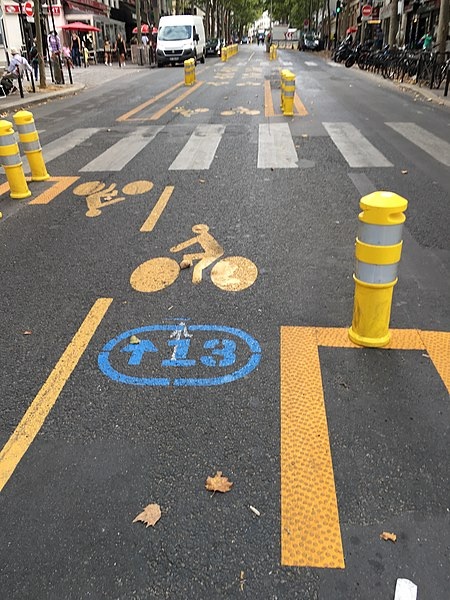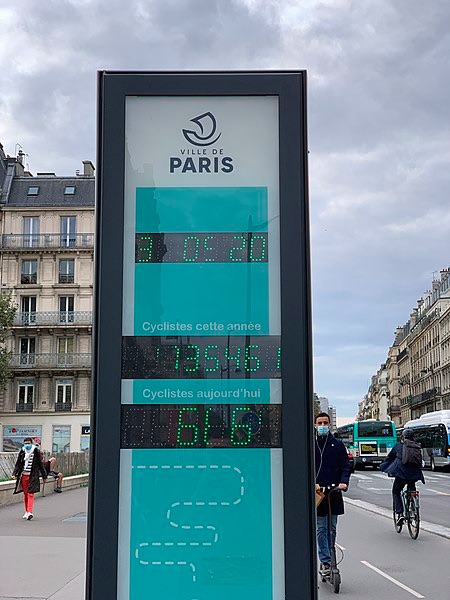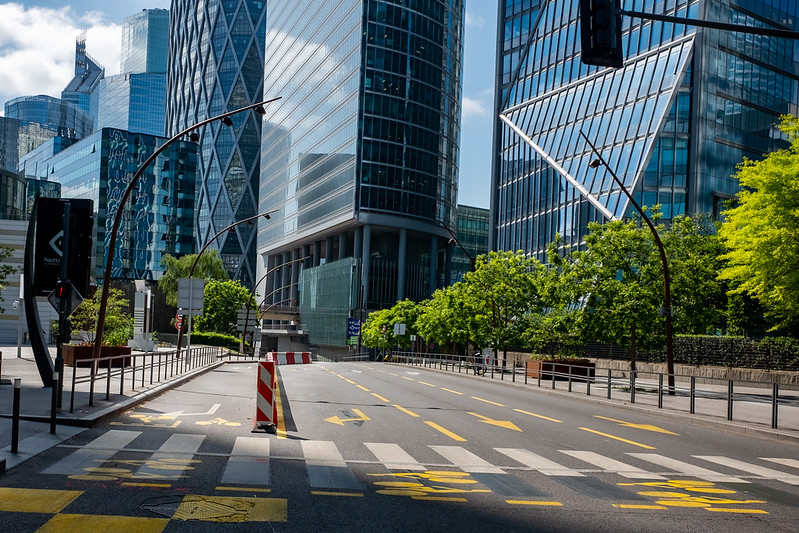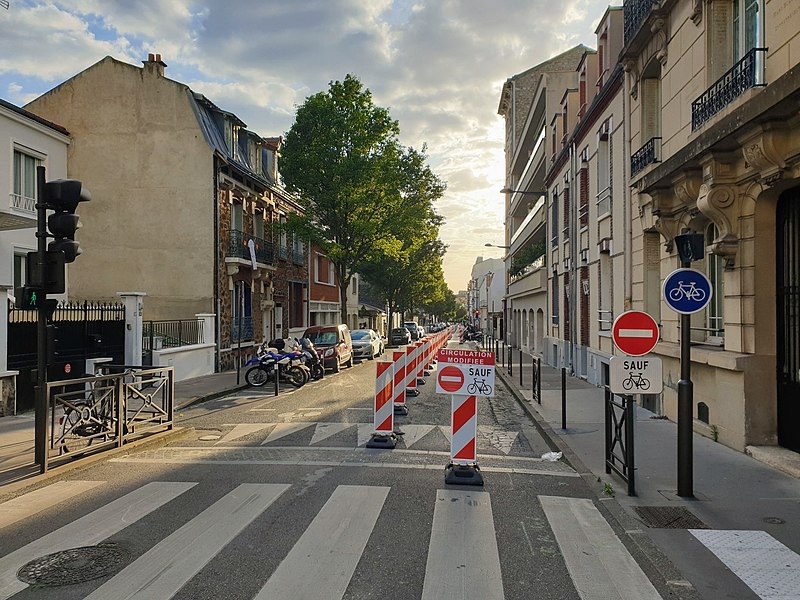The Corona cycleways and the new contours of the cycling city
Jérôme Denis and Nolwenn Garnier
May 2021
On May 13, 2020, the City of Paris announced the creation within a few weeks of cycleways to support the process of unlock-down after the first wave of the health crisis that had emptied the streets of the capital. In line with initiatives that had flourished all over the world, these lanes were already beginning to spread in a few cities in France, and were at the center of a regional policy designed to promote the modal shift of urban mobility, inaugurated one month earlier by the setting up of a “cycling committee” under the authority of the Prefect of Île-de-France. In Paris, they were the centerpiece of a set of temporary measures that included the pedestrianization of certain streets and the authorization for restaurants and bars to extend the surface area of their terraces onto the street. At a time of so-called social distancing, and a disaffection for public transport and its worrying promiscuity, these developments have significantly redistributed public space in favor of soft mobility, first and foremost cycling mobility.
Their implementation has been inspired by “tactical urbanism”, a model that advocates light and adaptable forms of planning. Initially operating in activist circles, this model is increasingly being adopted by many municipalities around the world. But beyond this lineage, the documents published on the occasion of this imlementation and the interviews that we were able to conduct within the Roads Division and the Urban Planning Department of the city of Paris show that a very particular form of urban experimentation has been invented with this initiative.
Beyond the usual spatio-temporal frameworks

The specificity of the experiments that have been going on in urban areas for the past few years lies in the rigidity of their spatial and temporal framework. Whether they are extensive, as in the case of testing an autonomous shuttle, or lighter, as when setting up a few “parklets” inspired by San Francisco experiments, they owe their experimental properties to the fact that they take place on a site with clearly delimited boundaries, and for a limited period of time, two conditions that are essential for monitoring their effects, and therefore for their evaluation. Eventually, once these experiments be conclusive, they face the issue of their replicability, or even their “scaling up”, which represent difficult challenges that mark the transition from the time of experimentation to the time of implementation. Interestingly, these two dimensions were notoriously absent in the case of the installation of temporary bicycle paths. In terms of space, first of all, far from being limited to a reserved area intended to playing the role of a representative sample of the territory, the “Corona cycleways”, as they are called in France (coronapistes), spread out in Paris over long distances, following for many the layout of the metro lines, and taking up in this respect past proposals made by several cycling associations Thanks to a strong coordination action led by the Regional Prefect, many axes have been even set up to ensure fluid traffic between Paris and several of its neighboring towns. The installation of the cycling lanes, although temporary, was therefore carried out on a 1:1 scale. Consequently, their perpetuation (recently confirmed by the City Hall, as for most French cities) will not change their overall geography. This is this the entire territory that became experimental in the process, before being transformed through the replacement of the mobile beacons and reinforced concrete barriers by more durable installations that are better integrated into the urban environment.
The temporality of the experimentation did not take the usual form either. Certainly, as their name suggests, the temporary cycleways were never intended to last in their initial form. And it was their temporary nature that allowed them to exist legally and materially, since they were designed with the standards and artifacts officially used to indicate road works, such as concrete barriers or yellow road markings. This temporary dimension, though, was not framed by any deadline that would have marked the end of the experiment. On this very aspect, things actually have become increasingly complicated, while the temporal uncertainty that went with the pandemics was growing stronger, and the announcement of a new lockdown loomed. In this context, it was impossible for the legal department to set a time limit for the traffic orders governing most of the concerned cycleways. Their only possible solution was to link the duration of these ephemeral infrastructures to the time of the national health emergency regime, which is itself regularly extended. It is still difficult today to predict how things will turn out, and to imagine how the perennialization process will concretely take over from this experimental situation. The only certainty is that the latter has largely gone off the rails of controlled experimentation, the results of which are sought to be precisely identified by ensuring its territorial and temporal enclosure.
Demonstrating the extent of cycling

That said, the experiment did give rise to some form of evaluation. It even produced particularly striking results, which were essential in the widely-shared decisions for perennialization. The temporary cycleways have borrowed a crucial element from more standard experiments: the installation of measuring instruments intended to give consistency to the consequences of the experimental assemblage. A large number of bicycle counters have been installed along the lanes, and in July 2020, the City Council commissioned an internal survey conducted among Parisian cyclists. The feedback turned out to be very clear: traffic doubled, and more than 40% of surveyed cyclists said they had started cycling in Paris during the first unlock-down, in spring 2020. These results were recently confirmed by a study that shows that cycling has increased significantly in many European cities following the installation of temporary cycleways.
In addition to the observed absence of traffic congestion, this was the main issue of an initiative that was part of a strategy clearly assumed by the Mayor of Paris well before the pandemic: to increase the number of cyclists in the city. In this regard, the experiment was a success.
Ultimately, the most prominent role that the implementation of temporary cycleways in Paris may have played is a revealing one, since they have highlighted a practice the extent of which had hitherto remained uncertain. As indicated in a report from the Regional Prefect, which gives a provisional assessment of the operation, “with a doubling of the number of cyclists, the success of the temporary cycleways is visible” (emphasis added). Hence, less than an experiment in the contemporary sense, the installation of temporary lanes, equipped with their measuring instruments, functioned according the principles of the first scientific experiments studied by S. Shapin and S. Schaffer[1]. It organized a public trial that proved to everyone the existence of a phenomenon: widespread cycling. On the scale of the entire territory, it became possible to demonstrate that a cycling city, not only equipped with dedicated cycling infrastructures but actually crossed by numerous and varied cyclists, was possible. As one of the persons in charge of the Roads Division explained to us, at the end of the first few weeks of using corona cycleways it had become “impossible to deny” the feasibility of a city in which cycling is a means of transport in its own right, rather than a leisure activit
The contours of a new form of governance
Because of its size and the speed with which it was set up, the initiative performed a demonstration on an unprecedented scale, which one can hardly imagine would have taken place in other circumstances. But that’s not all. The implementation of temporary cycleways has also shaken up the modalities of urban governance. Indeed, even if, as we have just recalled, it was in line with an already clearly identified political will, it is important to specify that its initiative and its concrete implementation were played out mainly within the city’s technical teams. And if the installation of the lanes itself seemed particularly fast, the importance of the preliminary studies that had to be carried out urgently to ensure that everything worked effectively on the operational and safety levels should not be minimized. It is thus within the technical teams that the project started for Paris, and that it was designed before being submitted to elected officials for validation.

At first glance, such takeover by the engineering department of an eminently political issue could be seen as problematic. Some may even consider it as an outright short-circuit of the democratic practices that characterize urban governance nowadays, since the design of the lanes and their implementation were not subjected to public consultations or to consultations with the district councils as it could otherwise have been the case for such a large-scale project. However, it would be a caricature to stick to this perspective. Whether it is about the cycleways or the pedestrian streets and the terraces installed on parking spaces, the provisional developments have in fact given rise to forms of reaction and ex-post adjustments that highlight another kind of democratic potential. Because it was designed from the outset on a trial-and-error model and assumed the need for situated corrections over time, the initiative added valuable flexibility to the urgency of implementation so that the concrete characteristics of the cycleways could be adjusted on a case-by-case basis to the needs and problems that emerged from the first moments of their existence. For example, following negative feedback from the city’s waste management services, whose agents were encountering problems collecting garbage, the Roads Division very quickly readjusted the routes concerned by designing new locations for the garbage cans so that agents would not have to cross the lanes at each stop.
In addition to this adaptability, the experimentation has also created new conditions for future debates and for the consultations to which each perennialization project will give rise. It will no longer be an abstract plan represented in the form of a map and a few figures that will be discussed collectively, but a concrete element of urban reality, with its existing uses and the sensitive experience that everyone have already been able to have.
An exceptional situation
What lesson can we learn from this experience? It is probably a bit early to say. Nevertheless, from the standpoint of the usual configuration of urban experiments in mobility, it can be emphasized that the situation is part of a movement of taking back in hand by the communities of forms of action that had been initiated for some years mainly by industrial groups. For years now, the latter were the main initiators of experiments dedicated to testing their innovations in “natural” conditions. Recently, a few new mobility players have even turn big cities into their playgrounds to implement their services and equipment in a strategy of “fait accompli” that local authorities have only been able to attempt to regulate a posteriori.

As for the experimental form as such, it should also be reminded how exceptional the situation that allowed the implementation of these temporary infrastructures is. Above of all, it is obviously due to the health crisis, which led not only to an unprecedented problematization of public space and its use, but also to a questioning of the obviousness of public transportation, reshaping the place of cycling in the formula of urban mobility. But that’s not all: before the first pandemic-related lockdown, Paris had experienced several weeks of a particularly successful transport strike, during which cycling mobility had increased considerably, despite difficult weather conditions. This strike period somehow served as a first step in the public demonstration that was later confirmed by the massive use of corona cycleways. On the other hand, the traffic conditions during the first unlock-down and the following months also played a crucial role in the consolidation of this demonstration. The very progressive return of cars in the streets probably facilitated acclimatization with the new infrastructure (change of traffic direction, narrowing of the lane, etc.) and made it easier to share the-space with a large number of cyclists now protected by dedicated equipment. Therefore, while it is obviously relevant to emphasize the operational and political success (and limits) of some of the aspects of this initiative, by pointing at how they could feed into future actions, its singularity should not be minimized. A unique period in world health history, the time of the pandemic was seized upon in many cities as an opportunity for an unprecedented experience, which has helped to reconfigure urban spaces and mobility practices on a lasting basis. We must undoubtedly accept the fact that, if there was an experiment, it was not carried out under conditions that would allow it to be replicated. Perhaps we must also have to admit that this is one of the keys to its success.
Jérôme Denis, Professor of sociology – Centre de sociologie de l’innovation, PSL – Mines ParisTech
Nolwenn Garnier, Research engeneer – Centre de sociologie de l’innovation, PSL – Mines ParisTech
This texte is based on a study funded by the Institut de la Mobilité Durable [Sustainable Mobility Institute]
Photo credit #1: Chris93 (25 July, 2020). “Marquage au sol de la piste cyclable provisoire Vélopolitain 13, avenue de Saint-Ouen à Paris” [Road markings for the temporary bicycle path Vélopolitain 13, avenue de Saint-Ouen in Paris] (CC BY SA)
Photo credit # 2: 1Chabe01 (30 September, 2020). “Compteur de vélos passant sur la rue de Rivoli près de l’hôtel de ville, Paris” [Bicycle counter on rue de Rivoli near the city hall, Paris] (CC BY SA)
Photo credit # 3: Julien B (23 May, 2020). Houilles-Meudon (CC BY 2.0)
Photo credit # 4: Camille Gévaudan (11 May, 2020). “Piste cyclable temporaire rue Diderot à Vincennes, ajoutée suite au déconfinement et ouverte le 11 mai 2020” [Temporary bicycle path on rue Diderot in Vincennes, added after the deconfinement and opened on May 11, 2020] (CC BY SA)
[1] Shapin, S., & Schaffer, S. 1993. Léviathan et la pompe à air : Hobbes et Boyle entre science et politique. Paris: La Découverte.

